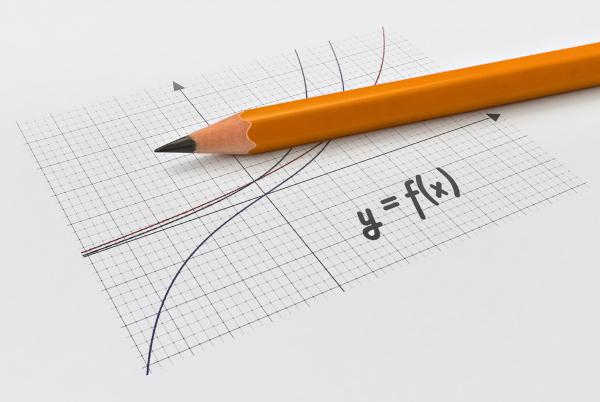A function is called polynomial function when its formation law is a polynomial. Polynomial functions are classified according to the degree of their polynomial. For example, if the polynomial that describes the function formation law has degree two, we say that this is a polynomial function of the second degree.
To calculate the numerical value of a polynomial function, just replace variable with desired value, turning the polynomial into a numeric expression. In the study of polynomial functions, graphical representation is quite recurrent. The 1st degree polynomial function has a graph always equal to a straight line. The 2nd degree function has a graph equal to a parabola.
Read too: What are the differences between an equation and a function?
What is a polynomial function?

A function f: R → R is known as a polynomial function when its formation law is a polynomial:
f(x) = anoxno + then-1xn-1 + then-2xn-2 + … + the2x2 + the1x + a0
On what:
x → is the variable.
n → is a natural number.
Theno, an-1, an-2, … The2,The1 and the0 → are coefficients.
The coefficients are real numbers that accompany the polynomial variable.
Examples:
f(x) = x5 + 3x4 – 3x3 + x² - x + 1
f(x) = -2x³ + x – 7
f(x) = x9
How to determine the polynomial function type?
There are several types of polynomial functions. She is classified according to the degree of the polynomial. When the degree is 1, then the function is known as a polynomial function of degree 1 or polynomial function of the 1st degree, or also an affine function. See below for examples of functions from degree 1 to degree 6.
See too: What is an injector function?
degree of polynomial function
What defines the degree of the polynomial function is the degree of the polynomial, so we can have a polynomial function of any degree.
Degree 1 polynomial function
For a polynomial function to be either degree 1 or 1st degree polynomial, the law of formation of the function must be f(x) = ax + b, with a and b being real numbers and a ≠ 0. THE degree 1 polynomial function it is also known as an affine function.
Examples:
f(x) = 2x – 3
f(x) = -x + 4
f(x) = -3x
Degree 2 polynomial function
For a polynomial function to be 2nd degree polynomial or 2nd degree polynomial, the function formation law must bef(x) = ax² + bx + c, with a, b and c being real numbers and a ≠ 0. One 2nd degree polynomial function it can also be known as a quadratic function.
Examples:
f(x) = 2x² - 3x + 1
f(x) = – x² + 2x
f(x) = 3x² + 4
f(x) = x²
Grade 3 polynomial function
For a polynomial function to be a 3rd degree or 3rd degree polynomial, the function formation law must bef(x) = ax³ + bx² + cx + d, with a and b being real numbers and a ≠ 0. The function of degree 3 can also be called a cubic function.
Examples:
f(x) = 2x³ - 3x² + 2x + 1
f(x) = -5x³ + 4x² + 2x
f(x) = 3x³ + 8x – 4
f(x) = -7x³
Grade 4 polynomial function
Both for the polynomial function of degree 4 and for the others, the reasoning is the same.
Examples:
f(x) = 2x4 + x³ - 5x² + 2x + 1
f(x) = x4 + 2x³ - x
f(x) = x4
Grade 5 polynomial function
Examples:
f(x) = x5 – 2x4 + x3 – 3x² + x + 9
f(x) = 3x5 + x3 – 4
f(x) = -x5
Polynomial function of degree 6
Examples:
f(x) = 2x6 – 7x5 + x4 – 5x3 + x² + 2x – 1
f(x) = -x6 + 3x5 + 2x³ + 4x + 8
f(x) = 3x6 + 2x² + 5x
f(x) = x6
Numeric value of the function
Knowing the role formation law f(x), to calculate the numerical value of the occupation for a value no, just calculate the value of f(no). Therefore, we replaced the variable in the formation law.
Example:
given the function f(x) = x³ + 3x² – 5x + 4, we find the numerical value of the function for x = 2.
To find the value of f(x) when x = 2, we will do f(2).
f(2) = 2³ + 3 · 2² – 5 · 2 + 4
f(2) = 8 + 3 · 4 – 5 · 2 + 4
f(2) = 8 + 12 – 10 + 4
f(2) = 20 – 10 + 4
f(2) = 10 + 4
f(2) = 14
We can say that the image of the function or the numerical value of the function, when x = 2, is equal to 14.
See too: Inverse function - consists of the inverse of the function f (x)
Polynomial Function Graphs
To represent in the Cartesian plane the function, we represent, on the x-axis, the values of x, and the image of f(x), by points in the plane. The points on the Cartesian plane are of the type (no, f(no)).
Example 1:
f(x) = 2x - 1
The graph of a 1st degree function is always a straight.

Example 2:
f(x) = x² - 2x - 1
The 2nd degree function graph is always a parable.

Example 3:
f(x) = x³ - x
The graph of the 3rd degree function is known as cubic.

Equality of Polynomials
For two polynomials to be equal, it is necessary that, when doing the Comparation in between you your terms, the coefficients are the same.
Example:
Given the following polynomials p(x) and g(x), and knowing that p(x) = g(x), find the value of a, b, c, and d.
p (x) = 2x³ + 5x² + 3x – 4
g (x) = ax³ + (a + b) x² + (c – 2) x + d
As the polynomials are the same, we have that:
ax³ = 2x³
(a + b) x² = 5x²
(c – 2)x = 3x
d = -4
Note that we already have the value of d, since d = -4. Now, calculating each of the coefficients, we have to:
ax³ = 2x³
a = 2
Knowing the value of a, let's find the value of b:
(a + b) x² = 5x²
a + b = 5
a = 2
2 + b = 5
b = 5 - 2
b = 3
Finding the value of c:
(c – 2)x = 3x
c – 2 = 3
c = 3 + 2
c = 5
See too: Polynomial Equation - Equation characterized by having a polynomial equal to 0
Polynomial Operations
Given two polynomials, it is possible to perform the operations of addition, subtraction and multiplication between these algebraic terms.
Addition
The addition of two polynomials is calculated by sum of yoursimilar hands. For two terms to be similar, the literal part (letter with exponent) must be the same.
Example:
Let p (x) = 3x² + 4x + 5 and q (x) = 4x² – 3x + 2, calculate the value of p (x) + q (x).
3x² + 4x + 5 + 4x² - 3x + 2
Highlighting similar terms:
3x² + 4x + 5 + 4x² – 3x + 2
Now let's add the coefficients of similar terms:
(3 + 4)x² + (4 - 3)x + 7
7x² + x + 7
Polynomial Subtraction
Subtraction is very similar to addition, however, before performing the operation, we write the opposite polynomial.
Example:
Data: p (x) = 2x² + 4x + 3 and q (x) = 5x² – 2x + 1, calculate p (x) – q (x).
The opposite polynomial of q (x) is -q (x), which is nothing more than the polynomial q (x) with the opposite of each of the terms.
q (x) = 5x² - 2x + 1
-q (x) = -5x² + 2x – 1
So, we will calculate:
2x² + 4x + 3 - 5x² + 2x - 1
Simplifying similar terms, we have:
(2 - 5)x² + (4 + 2)x + (3 - 1)
-3x² + 6x + 2
Polynomial Multiplication
Multiplying polynomial requires the application of distributive property, that is, we multiply each term of the first polynomial by each term of the second term.
Example:
(x + 1) · (x² + 2x – 2)
Applying the distributive property, we have to:
x · x² + x · 2x + x · (-2) + 1 · x² + 1 · 2x + 1 · (-2)
x3 + 2x² + -2x – 2 + x² + 2x + -2
x³ + 3x² - 4
polynomial division
To calculate the division between two polynomials, we use the same method we use to calculate the division of two numbers, the keys method.
Example:
Calculate p (x): q (x), knowing that p (x) = 15x² + 11x + 2 and q (x) = 3x + 1.

Read too: Handy Briot-Ruffini Device – Another Method for Calculating Division of Polynomials
solved exercises
Question 1 - The daily production cost of an automotive parts industry to produce a certain quantity of parts is given by the formation law f(x) = 25x + 100, where x is the number of pieces produced that day. Knowing that, on a given day, 80 pieces were produced, the production cost of these pieces was:
A) BRL 300
B) BRL 2100
C) BRL 2000
D) BRL 1800
E) BRL 1250
Resolution
Alternative B
f(80) = 25 · 80 + 100
f(80) = 2000 + 100
f(80) = 2100
Question 2 - The degree of the function h(x) = f(x) · g(x), knowing that f (x) = 2x² + 5x and g(x) = 4x - 5, is:
TO 1
B) 2
C) 3
D) 4
E) 5
Resolution
Alternative C
First we will find the polynomial that is the result of the multiplication between f(X and g(x):
f(x) · g(x) = (2x² + 5x) · (4x – 5)
f(x) · g(x) = 8x³ – 10x² + 20x – 25x
Note that this is a polynomial is of degree 3, so the degree of the function h(x) is 3.
By Raul Rodrigues de Oliveira
Maths teacher
Source: Brazil School - https://brasilescola.uol.com.br/matematica/funcao-polinomial.htm

